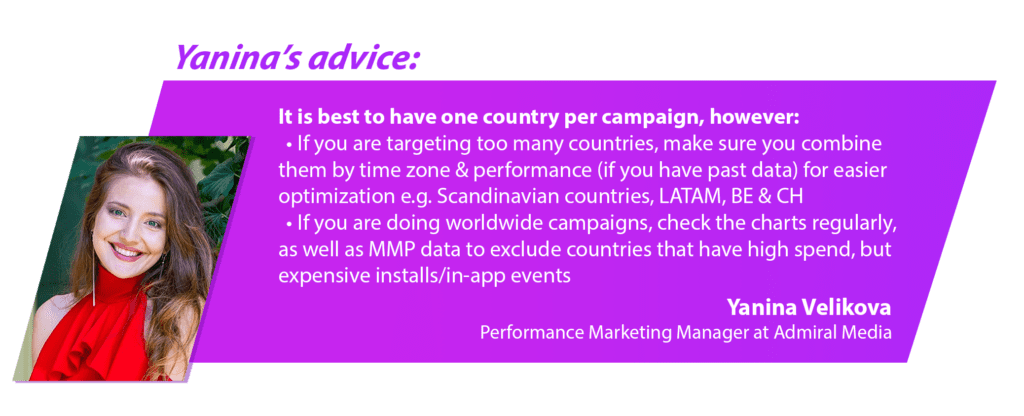Apple Search Ads (ASA) are a great way to drive traffic to your app. However, it can be hard to know where to start. Apple Search Ads are structurally different from other ad types like Facebook and Google Ads. Technically, it uses the app store listing information to populate the copy and creative that will be displayed within the ad. ASA mainly uses keyword-based campaigns. So, getting started with ASA advertising is relatively simple compared to other ad types because all you need is a list of keywords. Before you start running a campaign, it’s important to familiarize yourself with the different ASA ad accounts available. Apple Search ads have Basic and Advanced ad accounts. The Basic can be referenced as the automated version of ASA, where Apple makes the decisions on your behalf when it comes to displaying ads to which users. With the Advanced ad account, however, you have complete control over your campaign and all its settings including your keywords, target audiences, and using Custom Product Pages (CPP). With this being said, here are some tips that will help you optimize Apple Search Ads.
Table of Contents
Tips on Account structure for Apple Search Ads (Search Results Campaign)
Structuring an Apple ads campaign can be daunting, especially if you’re a first-timer. Fortunately, we have nailed down the process into three key areas:
- Campaigns
- Ad Groups
- Keywords
Campaigns
To get the most out of your Apple Search Ads ensure that your account has an appropriate and clear structure. Having a clear vision of your objectives and being organized will have a significant impact on the performance of your campaigns. A clear campaign format allows you to use automated scripts, helping save time. Later on, we will take you through each campaign type and tips to apply to each type. There are a number of account structures you can utilize. We recommend a semantics-based account structure, which entails five campaign types: Brand, Generic, Discovery, Competitor, and Probing. When deciding on a campaign structure, consider both scale and performance. For example, If your primary goal is to scale your app and expand its current reach, discovery campaigns can help you find similar competitors or keywords in your sector. This is accomplished automatically with the assistance of the algorithm used when activating the Search Match feature. On the campaign level, you can specify the location targeting which helps you separate your markets and allocate budgets accordingly. Here’s what our Apple Search Ads expert, Yanina Velikova, recommends:  Learn More: Apple Search Ads Agency
Learn More: Apple Search Ads Agency
Ad Groups
Ad groups are the people you want your ad to be shown to. When identifying your ad groups and audiences, Apple Search Ads (Advanced plan) enables you to be extremely particular. Concurrently, using these options to narrow the target group excludes users who do not consent to ad tracking. This varies from market to market. “Looking specifically across the countries and regions where Apple Search Ads is available, devices with Personalized Ads turned off drove 78% of iOS 15 search volume on the App Store in the first quarter of 2022.” said the Apple Search Ads team. The good news is that you still can target the remaining Apple users with the following criteria:
- Device (iPhone or iPad)
- Customer type (new vs returning)
- Gender
- Age
- Schedule (When you want them to see your ad)
We recommend segmenting semantics-based campaigns (particularly competitor and generic campaigns) into several Ad Groups (all with Exact match keywords). Divide ad groups by their level of interest in your app. For instance, for a meditation app, we have the Generic campaign divided into Meditation, Sleeping, Breathing, and Relaxation ad groups.  Segmenting ad groups like this can help you optimize for performance by allowing you to work more accurately with CPA goals and creative sets.
Segmenting ad groups like this can help you optimize for performance by allowing you to work more accurately with CPA goals and creative sets. 
Keywords
Once you’ve created your ad groups, it’s time to structure your keywords. Keywords are the terms people use to search for apps in the Apple App Store. You can tell Apple which keywords you want your ad to appear for in Apple Search Ads Advanced. Different keyword types should be used for different campaign types. For example, if you are undertaking a competitor campaign, your keyword list should include the names and name variations of your competitors. Here are some tips on how to manage and optimize your keywords for ASA;
Keyword Management
- It’s important to not mix different match types in one ad group.
- Keep your keyword list concise, especially at the beginning of a new campaign.
Keyword optimization for Apple Search Ads
To optimize keywords for Apple ads, it’s essential to know when to add certain keywords and when to pause others. This will be done during the probing phase of your campaigns.
- Your best-performing keywords should be added as an exact match to your exact-match ad groups
- Don’t raise your bids for competitor keywords, it will just up your cost.
What keyword types are available, and what does each one mean?
- Broad Match: When you use a broad match keyword, your ad will show up when people search for related terms and phrases.
- Exact Match: Exact match gives you the most control over searches in which your ad may appear. You can select a term and its close variants, such as common misspellings and plurals. As a result, your ad may receive fewer impressions, but your conversion rate on those few impressions may be much higher. This is because you’re reaching customers who are directly interested in your app.
Tips on optimizing bids
- Apple Search Ads provides insights into your bids on the keyword dashboard. The strength of each bid is highlighted in either green, yellow or red to indicate strong, moderate, or weak bids.
- The strength of your bid showcases the likelihood of your ad being shown to target audiences. In the case your ad is in the red, it’s time to rethink your keyword strategy.
- Keep your bid increases at 15% to 20% maximum every 2 days or twice a week. A significant increase will affect your campaign negatively.
Tips on Campaign structure for Apple ads
There are five main campaigns we suggest you run per market:
- Brand
- Generic
- Competitor
- Discovery
Let’s take you through some tips for each campaign type:
Brand
For 1 Brand campaign with one Ad Group that has Exact Match keywords only. The broad match will go into your discovery campaign. There are numerous reasons for distinguishing the brand campaign from other non-brand campaigns. Firstly, you will most likely want to protect your brand from competitors who are bidding on your brand keyword, threatening to take from your user base. You can also estimate the impact of a campaign by attributing users who came in directly after the ad went live, through a brand search. Also, don’t forget to check how you rank on your brand keywords using the impression-share reports. It can also help you understand how bid changes affect this ranking. The cost-per-click for a Brand campaign is generally the lowest, the CPI too. This is primarily due to the high tap-through rate, which allows you to win keywords with low bids. On the other hand, you might have converted the vast bulk of that traffic organically. Separating your Brand campaign allows you to better understand the organic fragmentation, as well as helps you determine spending. 
Generic
The goal of a generic campaign is to target broad terms – not broad match – that is related to your app but do not specifically incorporate the brand.  A generic campaign should cover all of the app’s offerings and features. We recommend segmenting Generic campaigns into several Ad Groups (all of which should be set to exact match) that represent different values.
A generic campaign should cover all of the app’s offerings and features. We recommend segmenting Generic campaigns into several Ad Groups (all of which should be set to exact match) that represent different values.
Competitor
Similarly to how we recommend structuring a competitor campaign, we suggest dividing the Competitor campaign into several Ad Groups based on different audiences’ likeliness to download the app. In this case, only exact-match keywords should be used. Also, you can divide competitors either by topic just like the generic campaign’s approach or by top competitors.
Discovery
The primary function of a Discovery campaign is to find keywords that you haven’t included in your other campaigns. There are 2 AdGroups for this purpose, 1) Search Match where you allow ASA to find keywords based on the description and title of your app store listing 2) Broad Match where you add a couple of broad match keywords and ASA extends them to find more keywords you might want to target. Don’t forget, you need to add all exact Match keywords – from all the other campaigns – as a negative match in the Discovery campaign. You need to avoid keywords that you’re already targeting in other campaigns. So, add keywords used in other campaigns as negative keywords on the campaign level.
Conclusion
Apple Search Ads is one of the most complicated ad channels, and it requires a lot of work. We do that efficiently using automation scripts that help decrease the duplications you might have in your ad account. We also structure your account in the best way possible to get you the lowest cost per install on the dollar. Book a call or send us a message to learn more.





